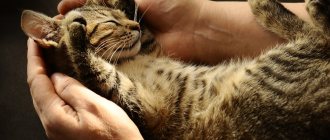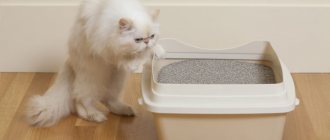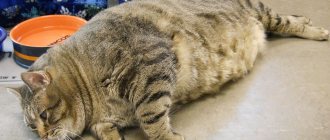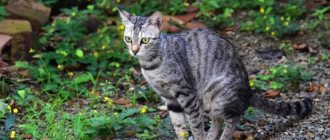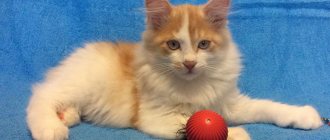Any owner of a meowing pet knows how cats love to tear up furniture, door frames, wallpaper or carpets. And there is no point in scolding a cat for this. An animal needs to sharpen its claws, and that is why, from an early age, you can notice the habit of tearing up your favorite furniture in your furry friend. For various reasons, cats tear apart vertical and horizontal surfaces. This way they can mark territory, sharpen their claws and scratch their paw pads.
The kitten should be taught to sharpen its claws on a special device as early as possible. It will be much more difficult to wean an adult cat from damaging door frames and the sofa. Scratching posts are very popular. There are quite a lot of their varieties: from small floor and wall-mounted ones to large ones that combine several functions. They will be discussed below.
There is no point in weaning an animal from sharpening its claws, but there is a solution to the problem
Why do cats sharpen their claws?
Claw pointing is a natural process that occurs in every cat. Many owners believe that this action is nothing more than cat pampering or an attempt to harm. This opinion is fundamentally wrong. The habit of sharpening claws is equivalent to pulling up and playing with a ball. That is, it is necessary to maintain health and normal physical shape.
In addition, with the help of the point, the cat is freed from too long and exfoliated claws. If you do not allow the animal to carry out this action, then it will try to chew them off, which will lead to their fragility and delamination. This can cause inflammation of the nail bed.
Getting rid of bad and long claws and physical activity are not the only reasons. If we talk about the innate instincts that are inherent in every four-legged animal, then this process is needed to mark the territory. It is known that a special liquid is secreted through the pads on the paws - a secret that is felt only by animals. This action should demonstrate to everyone who is boss and show that the territory is already occupied.
While sharpening their claws, cats often damage furniture.
In addition, after waking up from sleep, cats need to warm up their muscles. To do this, they stretch out and cling tightly to the carpet or sofa with their claws.
Many veterinarians believe that this procedure is a great way for cats to relieve stress, expel all their anger and release excess energy.
Important! It is best to start learning in childhood. Kittens are very inquisitive and absorb new information like a sponge. It is much more difficult to train adult cats, who have long tested the strength of carpets and furniture upholstery.
Popular questions
Does your cat want to sharpen her claws on the scratching post?
It happens that a cat ignores the scratching post. Perhaps he doesn't like her and needs someone else. If you don't mind the money, you can buy another one and check it out. Another option is to sprinkle the scratching post with catnip, which cats love so much. Just don’t overdo it, because mint stimulates the nervous system. As soon as the cat falls in love with the scratching post, the mint should be discontinued.
Similar actions can be done with valerian. You can also buy a special spray for accustoming to the scratching post: it will put the cat in a playful mood and he will love the right place. Another method is to take the scratching post into a house with other animals and have the other cat sharpen its claws. This way she will leave her mark there, and when you bring the scratching post home, your cat will want to re-mark this place.
Does your cat sharpen its claws everywhere?
It also happens that a cat loves a scratching post, just like other places in the apartment. There are several solutions to this problem. The simplest thing is to block the cat’s access to his favorite place with some object. You can also spray with special sprays that repel cats. They usually have citrus smells, which tailed animals don't like.
But the trouble is that these repellers do not work for many. An unpleasant, but effective option is to spray the cat with a spray bottle every time he tries to do something he shouldn’t. But there are costs here. The cat is not a fool, he will remember that it is impossible only when the owner sees, that is, when he does not see, it is possible. As a result, your furniture will still be tattered.
Cats are masters of doing dirty tricks on the sly. Or maybe the opposite situation occurs - the cat sharpens its claws where it should not, only in the presence of the owner. This is already a psychological problem and it means that in this way the cat wants to draw your attention to himself. This is some kind of manipulative technology.
One day the cat noticed that no matter what he did, the owner was busy with something and did not pay attention to him, but as soon as he did something forbidden, suddenly his person was in demand. He will remember this situation and now every time he will try to get you with the point of his claws or other unwanted action. If so, then we can only congratulate you.
You will have to either fence off the object of damage, or try to sit out the cat, completely ignoring it. By doing this, you will make it clear that the manipulative technology does not work - and the pet will remain empty-handed, after which it will leave its occupation. Do not forget that sharpening the claws on objects is also a way to mark the territory due to the marks left behind and a special secret that stands out on the pads. Accordingly, another reason why a cat can tear up everything is marks. And this means that he does not feel very confident in your apartment. Think about why exactly and try to fix it.
Video
Options for scratching posts and their types
Nowadays you can find many types of nail clippers in pet stores. They can be of different shapes, have different material composition, size and, accordingly, vary in price.
Main options for scratching posts:
- Columns. The most common and frequently purchased models. The pillars can be of different heights and widths. Therefore, this design can be easily adjusted to the height and weight of your pet. Pillar-shaped claws are wrapped in different materials. With the help of this device, a cat can not only sharpen its claws and get rid of old plates that interfere with the process of movement, but also strengthen the spine, joints, and stretch muscles. It is very useful. After all, most pets prefer a sedentary lifestyle and spend maximum time sleeping. Therefore, the load will not harm them. If we talk about order, then the drapery column is a very advantageous design. After all, it is much easier to collect fallen claws in one place than to look for them throughout the apartment.
Scratching post - column
- House. This drape performs two functions at once. The pet can sleep and exercise in it. The structure is covered on all sides with a special fabric. Therefore, there is no need to worry that the cat will ruin the structure. The pet can safely sharpen its claws in any area of the house.
Claw-claw - house
- Complex. Far from cheap, but at the same time a convenient option. Everything an animal needs for a full life is concentrated here - a place for sound and restful sleep, games, exercise and sharpening of claws. The device consists of numerous shelves, baskets, houses, columns, etc. The pet can spend here all day long, only occasionally leaving to relieve itself or eat.
Complex - scratching post
- Wall-mounted or vertical scratching post. Perfect for those purrs who like to spoil wall wallpaper with their claws. The models are presented in the form of wall boards. If your furry pet is used to picking off corners, then a corner scratching post is ideal for him. These are two boards that are attached to two walls.
Vertical corner scratching post
- Horizontal drape. Presented in the form of a small rug on which the cat can sharpen its claws. You can simply place it on the floor in a place where your pet likes to spend time. There are horizontal draperies with curves. This makes the process of sharpening claws more convenient. There are also volumetric structures, which are presented in the form of a pillar with a wide base.
Horizontal claw scraper
The claw boards are sheathed with various materials. The most accessible and quickly perishable is cardboard. It is most suitable for kittens. Adult cats can damage and tear it within a few weeks.
Cardboard drape
Another popular material is jute. It is more wear-resistant than the previous version. But the most important thing is that cats like jute more than all other materials. It is made from plants of the Malvaceae family, which are often used to create various weaving products, including ropes. A post made of jute can please your pet for several years.
Jute scratcher
The most wear-resistant and durable is sisal. Made from the leaves of the agave plant. The strands that wrap the scratching posts turn out to be rough and prickly. The structure is a bit like wood bark. This material lasts quite a long time.
Sisal nail clipper
Another material used for scratching posts is wood. It is carefully polished before sale. The material is durable. However, if made poorly, there is a possibility of injury to the paws or introduction of a splinter.
Wooden scratching post
Table 1. Comparative characteristics of the best scratching posts.
| Name | Short description. Dimensions, cm | pros | Minuses | price, rub. |
| Yami-Yami scratching post | Presented in the form of a flat round plate. Covered with jute material. 9.2×43.0 |
| Narrow. | 400 |
| Petmax Marine scratching post (wave) | The drape has a wave shape. The walls are lined with sisal. 50.0×18.0 |
| 1500 | |
| Basilio pillar with stable stand | Covered with jute thread. 36.0×52.0×36.0 |
| Weighs 4.5 kg. | 1500 |
| Lorca Trixie scratching post at an angle | Semicircular. Sheathing material is sisal. 37.0×27.0×75.0 |
| High price. | 4000 |
| Rugs with attached toy from Trixie | The surface is covered with sisal material. The color of the drape is your choice. 46.0×70.0 |
| 1500 | |
| Sheep with round shelf from Zolux | A column on top of which there is a sheep in the form of a round shelf in which the pet can hide or sleep. Made of wood. Covered with sisal material. 30.0×30.0×62.0 |
| High price. | 4500 |
| Claw-toy “Mousetrap” from Bradex | Made of high quality plastic. It is presented in the form of a platform, on top of which there is a claw sharpener made of carpet. 25.0×6.5×25.0 |
| 424 | |
| Cardboard scratching post “Fish bone” by Karlie Flamingo | Made in the shape of a fish bone from corrugated cardboard material. 11.0x12.0x48.0 | There is a carrying handle. | Short-lived. | 800 |
| Claw sharpener-house “Mouse” from CLP | Made in the form of a house. There is a sisal drape on the top. 33.5×51.0×27.5 |
|
| 1700 |
How to choose and where to place a scratching post
If the pet is already an adult, then the first thing you need to pay attention to is the place where he likes to engage in claw points. If it is a carpet, then it is better to give preference to horizontal models. If these are walls, doors, corners, then vertical. The right choice will allow the cat to quickly understand what you want from it, and the training will go much faster.
If you plan to buy a vertical scratching post, then it must be stable. It should not swing from side to side, topple or fall under the pressure of the animal. Such a model will not bring any benefit, and the cat is unlikely to come close to it anymore.
The height of the cat must also be taken into account. The height of the drape should be slightly larger than the size of the pet. It is ideal if the animal's claws do not reach the top of the structure for the point of the claws.
Choosing the right location for a scratching post is the key to success
The device should be installed where the cat does it most often. If it's a door, stick it there; if it's a carpet, lay it on the surface. Of course, it is not always convenient when the scratching post is under your feet or in the aisle. But this is only temporary, until the cat understands the purpose of this useful thing. When this happens, you can gradually move it away and, in the end, place it where it is convenient for you.
Important! It makes sense to place the nail clipper where the cat sleeps most often. After all, after waking up, cats love to stretch out and sharpen their claws.
The best location for the scratching post is where the cat sleeps most often.
How to train an adult cat to use a scratching post
Many owners make the irreparable mistake of screaming and hurting their pet after the next claw point on the sofa or carpet. Of course, this is terribly annoying. However, as mentioned earlier, this is their natural instinct, so the animal will not understand why the owner’s anger is justified. It is better to shout out his name or strictly say “no!” while sharpening his claws on the furniture. Gradually, your pet will begin to understand what is causing your indignation.
Some cats are very vindictive. Therefore, if you constantly beat them or scream, then they are capable of committing meanness - relieving themselves in their slippers, favorite shoes, or in the bed.
Important! If your pet constantly sharpens its claws on the carpet or furniture, spray it with water from a spray bottle. Contact with any liquid is unpleasant for cats. Therefore, after some time, he will associate the process of touching the sofa with a nuisance that must be avoided by all possible means.
Kitten's reaction to punishment
In addition, this is an excellent opportunity to show him a new design - a scratching post - and show him how to use it correctly. Just place your pet's paws on the surface of the drape and imitate the dot process. When your cat releases his claws, praise him, pat him on the head, or give him his favorite treat.
The cat gets acquainted with a new scratching post
Attention! Cats love it when their owners praise them. Moreover, the gingerbread method is much more effective than the stick method.
If your furry pet completely refuses to sharpen its claws on the design that you showed it, and persistently continues to spoil the furniture covering and walls, try putting a couple of sprigs of catnip (catnip) on the nail sharpener. The herb is sold at any veterinary pharmacy or pet store. This will attract the cat, and she will definitely pay attention to the new design and, perhaps, figure out how to use it on her own - without additional actions on your part.
In order to discourage your cat from places where she likes to sharpen her claws, spray them with water diluted with orange, lemon, and grapefruit esters (2 drops per half glass of water is enough). This will definitely keep your pet away from his favorite furniture, carpets and wallpaper.
Important! Some owners practice this method. They stroke their pet with a handkerchief with the scent of someone else's cat. Naturally, the pet will not withstand such impudence and will want to get rid of the enemy who has encroached on its own territory. Hang the scarf on the scratching post. Then the cat will definitely want to vent all his anger on her, trying to rip off the hated scarf from her.
This method will also be useful. It is used if all others are useless. Cover all the cat's favorite places with plastic, and reward him with his favorite treat for each use of the scratching post. Cats really don’t like polyethylene because it’s impossible to grab onto it with their claws. Of course, this method is not always convenient, but it is very effective.
Scratching post - wave
For the same purposes, it is advisable to use double-sided tape. The paws will constantly stick, and cats really don’t like that. Surely, one attempt will be enough to repel your pet from the surface of the furniture. Then he will look for another convenient place. Now is the time to show him the scratching post.
Attention! You can use cinnamon, black pepper, regular powder, or curry spice as repellents. If an animal touches the surface with its paws, dust will rise and clog the fidget’s nose. This will scare the animal away forever.
What to do first and what to do next?
- Place the nail clipper in the desired location.
- You shouldn’t immediately “hook” your cat onto a sharpener, because new objects sometimes cause fear in animals. A persistent acquaintance can scare your pet away from the structure forever. So wait a while. Let the cat first come up to it, smell it, and examine it. This may take several days. Be patient.
- When familiarization occurs, try to show the animal how to use this item.
Scratching post on the wall
- Don’t insist, let your pet understand how nice it is to sharpen his claws on a cloth.
- If this does not happen, and the cat stubbornly continues to try to ruin your furniture, then every time it tries to do this, take the cat to the scratching post and run its paws along the surface.
- Try to repeat these steps several times a day.
Believe me, your efforts will definitely pay off soon.
Selection and installation of a scratching post
Smart owners understand that cats obey instincts, and it is a waste of time to scold them for damaging furniture. Observing the preferences and physiological characteristics of the cat will help you choose the right scratching post:
- Watch your pet, take a closer look at how he prefers to sharpen his claws - on a horizontal surface or on a vertical one. Based on your observations, choose a suitable model in the store (mat, column, curved form).
- The size of the fight must correspond to the size of the animal. The scratching post should be such that the cat can stretch out freely while scratching it.
- If the fight is placed unstable, the cat may ignore it. Choose a model with a wide and heavy base.
If you have the time and desire, you can make a scratching post yourself. It will be cheaper, and you can make just such a thing that fits perfectly into your interior.
Types of structures
What types of scratching posts will be functional, fit into the interior, help the cat relieve stress, and help the owners keep their furniture upholstery, shoes and wallpaper intact?
- Vertical
. All versions of floor posts braided with rope are popular due to their small size and structural stability. Vertical columns start from 50 cm (suitable for accustoming a kitten to a scratching post) and are limited only by the budget and the height of the ceilings in the owners’ house. A single vertical column can be easily placed in small spaces to target areas that cats like to pick at.
- Game complexes
from several vertical planes of different levels, with shelves and beds, perhaps with different textures of materials, they take up more space and are more expensive.
- Planks
. The advantages of planks braided with jute, rope, fabric, laces or upholstered in fabric include mobility and small size. They can be used to cover the cat’s favorite place on the wallpaper or furniture.
Whatever scratching post you choose, the main thing is that it copes with the expected tasks and does not just accumulate dust.
Size and material
Observe your cat before purchasing: does she like fabric surfaces or does she manicure on cabinet furniture? Perhaps she liked wood or a completely unusual material? Observation will help you decide on the choice of covering and will eliminate the fact that the animal will ignore the scratching post.
Owners often learn how to accustom an adult cat to a scratching post through trial and error. To avoid them as much as possible, you need to pay great attention to the habits and character of your pet.
You should stock up on patience and treats to reinforce the results.
Offer different materials: strips of corrugated cardboard, balls of woolen thread.
The height and thickness of the scratching post should correspond to the size of the animal. The Maine Coon will not sharpen its claws on a small and unstable board - it simply will not impress him. The opposite situation: it will be difficult for a kitten to peel off a surface with a large weave - it will get caught in its claws and will not be able to get out.
Where to put
If attempts to tear up furniture or a wall have already been made, then it is best to place the scratching post in this particular place. After installing the device, it is better to block off the places of other “attacks” so that they do not attract the pet’s attention again.
It’s good if the cat independently appreciates all the charm of the new item. If the animal does not understand the first time why fighting is needed, continue training until the necessary skill is formed.
After your pet has become familiar with the scratching post and has learned to use it, and you are sure that the bad habit is already a thing of the past, start moving the scratching post. Move it daily, little by little, until it is in the place you have chosen for it.
If the apartment is large or there are several cats in the house, it is useful to purchase not one, but several scratching posts and place them in different places. The best place to place a scratching post is next to the bed. As soon as the cat wakes up and wants to stretch, she will turn to the device.
How to teach a kitten to use a scratching post
Unlike an adult pet, it is much easier to accustom a kitten to a scratching post, because babies do not yet have traditional tastes and habits, and therefore the process takes a little time.
Accustoming a kitten to a scratching post
Kittens begin to master the process of sharpening their claws from any first surface they come across that they can cling to. Here the owners begin to come up with a clever plan to wean the baby from this habit - they either purchase silicone tips for the paws, or completely remove the claws surgically at the veterinary clinic. Why deprive a cat of such joy? Let him sharpen if he wants. Your task is to teach him to do this in a place convenient for you.
For babies, it is better to purchase horizontal scratching posts or rugs made of jute or sisal.
Rug with attached toy
Important! It is not recommended to buy drapes made of wood for kittens. The fact is that babies' paws are too tender. The tree can injure the kitten’s still sensitive skin.
You can purchase a vertical board, selected specifically for the height of the baby. The advantage of such designs is that as its size increases, the claw blade moves higher. Then there will be no need to purchase a new sharpener.
Attention! You need to accustom your baby to draping when he shows the first signs of releasing his claws and begins to encroach on carpets, wallpaper and furniture. This usually occurs at the age of 1 month.
Ideally, a toy in the form of a mouse or ball will be attached to the structure. This will certainly attract the attention of the little fidget and at the same time introduce him to the scratching post. The method of encouragement also works in this case. If your baby has sharpened his claws in the right place, pat him on the head as quickly as possible and give him his favorite treat. This must be done constantly until the kitten gets used to the drag.
Scratching post included with toy
Ten quick ways to help train a kitten to use a scratching post:
- Play with your baby near the drape. Try to make the kitten involuntarily cling to the surface of the structure with its claws. When he feels it with his paws, he will immediately understand its direct purpose. Don't forget to encourage your baby and appreciate his actions.
- There is no need to take a small kitten's paw and run it along the scratching post. The baby will think that you want to harm him and will feel defenseless. With such actions you can scare the kitten away, and he will no longer want to deal with the drag. Such manipulations can only be carried out with an adult cat.
- Place some valerian on the scratching post. This will get his attention. And sprinkle your favorite places for scratching with citrus juice.
Cats love the smell of valerian
- To attract your little one's attention to the claw point structure, attach a small toy or ball to it. The baby will play and sharpen his claws at the same time.
- Bring the kitten to the structure after each awakening. He will definitely want to sharpen his claws.
Be patient and don't expect quick results. Kittens are different, and sometimes understanding comes to them very late.
Video - How to accustom a kitten to a scratching post
Training in action
How to train a cat to use a scratching post
The kitten needs to be accustomed to the scratching post gradually, because the baby may not immediately understand what it is. What is the fastest and easiest way to train a pet to use a scratching post? It is impossible to answer this question unequivocally. Everyone introduces their pets to the scratching post in different ways. This is understandable, because each cat has its own habits, character and behavioral characteristics.
Important! There are a lot of options on how to accustom a kitten to a scratching post. But before that you should prepare. First you need to decide on the place where the claw sharpener will be placed.
Places that have been used more than once by the animal as a scratching post will need to be hidden from the reach of its claws.
If the cat does not recognize the scratching post
To prevent drag training from seeming like a complete nightmare due to the cat’s resistance, you need to think about what exactly caused it. Perhaps she is not satisfied with the location of the structure. Place it for a while where your pet likes to do it. If this doesn't work, do this:
- hang your cat’s favorite toy, rattle or bell on the scratching post;
- buy several draperies and place them in all your pet’s favorite places;
- treat your favorite areas for the point with citrus juice, and the drape with catnip or valerian.
Important! If there are several cats in the house, then it is enough to train one so that all the others can prove their dominance in this territory.
Collective use of scratching posts by cats
Choosing a scratching post
When choosing a scratching post for a kitten, be sure to pay attention to the following parameters:
- Material. Most of all, animals love twine, carpet or durable cardboard.
- Compliance with all safety requirements. Products must be attached to the surface as securely as possible and not fall from the weight of the animal.
- Dimensions. For small kittens, it is better to use smaller scratching posts. However, as the animal grows, the product should be changed to a larger one.
- Design. Today, manufacturers produce both simple and more universal scratching posts with houses and toys that can perform several functions at once and thereby definitely attract the attention of the fluffy one.
You can also choose a scratching post by considering what surface the animal likes to sharpen its claws on. If it's a carpet, take a closer look at products made from carpet or twine. If the wallpaper is for cardboard models.
The products also differ in price. The most inexpensive are jute and cardboard. While wooden or sisal scratching posts are more expensive.
If, for health reasons or based on the breed, the kitten needs to further strengthen the muscles of the back and shoulder joint, it is better to choose a scratching post with a column design. It will be able to strengthen the musculoskeletal system. The main thing is to choose the right height, which for an adult pet should be 70 cm, and for a small kitten – 50 cm.
As the animal ages or simply as the scratching post is used, it must be changed in a timely manner. The replacement time can be judged by observing the animal. If you notice that the cat sharpens its claws less actively in a specially designated place, then the scratching post is no longer suitable for this purpose.
How to accustom a cat to a new scratching post
It often happens that a cat completely refuses to use a new nail clipper, even though the old one already looks like a completely holey and shabby object that should have been thrown out long ago. What should you do if your pet doesn’t recognize the new claw point attachment?
- Cut a piece from the old drape and attach it to the new one. The familiar smell will help instill confidence in the newly purchased design.
- After your cat wakes up, bring her to the new claw point. Let her use it for her own purposes.
- Do not scold your pet if he refuses to use the cloth to sharpen his claws and, especially, do not poke him with his muzzle. This can scare the cat away and permanently discourage him from performing the activity where you want it.
Don't swear at the cat!
Take your time. Sometimes it takes a lot of time to accustom a cat to a new device.
If the kitten doesn't listen
Do not hit a kitten under any circumstances if it sharpens its claws in the wrong place. The correct association will not arise in the baby’s head, and the pet will be afraid of you. To help the kitten understand that the sofa is not a scratching post, follow the recommendations:
- Scold the kitten only at the moment of hooliganism. It is necessary for the pet to experience negative emotions when experiencing unwanted behavior;
- Keep a loud object, such as a jar of change, nearby. Rattle when the kitten starts sharpening its claws in front of you;
- Try a spray bottle with water - many cats only need one spray;
- Cats don't like citrus smells, so spray your upholstered furniture with it. Also try special repellent sprays;
- Place double-sided tape on the sofa: the kitten will be scared and will not touch this place again.
The best way to get rid of bad behavior is to create good behavior.
Scold the kitten when he does a manicure in the wrong place, but immediately afterward take him to the scratching post and give him a treat. The cat will understand that it is bad not to sharpen its claws at all, but to sharpen its claws on the sofa. This way you will maintain a good relationship with your pet and your furniture. Did you like the article? Share with your friends!
How to make a scratching post with your own hands
A scratching post can be purchased at any pet store. But it’s doubly nice when the design for your beloved pet is made by yourself.
Video - How to make a scratching post with your own hands
How to build a vertical claw sharpener yourself?
- There is no need to attach the drape to the wall. It is better to attach it to a wooden panel. The width can be any (as the owner wishes). But the height is not. It should be equal to the height of the claw sharpener. If you decide to “build” a draperies in the corner of the room, you will need 2 panels.
- The height of the bar depends on the size of the cat (2 pet lengths). Calculations are made without taking into account the tail.
- Buy 2 skeins of jute. This is usually enough for a regular nail polisher. Diameter approximately 5 mm.
- Take a drill, screws, a block.
- Drill holes in the beam and panel at the same time. There should be 6 of them in total - 2 on top, 2 on bottom, 2 in the middle.
- Before wrapping the structure, insert the screws into the holes you made.
- Wrap the beam. At the same time, carefully fix the ends of the thread.
- Attach the block with thread to the panel with screws.
Now you can call the cat to test the new scratching post.

